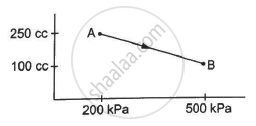Advertisements
Advertisements
प्रश्न
A person of mass 60 kg wants to lose 5kg by going up and down a 10 m high stairs. Assume he burns twice as much fat while going up than coming down. If 1 kg of fat is burnt on expending 7000 kilo calories, how many times must he go up and down to reduce his weight by 5 kg?
उत्तर
Given, the height of the stair = h = 10 m
The energy produced by burning 1 kg of fat = 7000 cal
∴ The energy produced by burning 5 kg of fat = 5 × 7000 = 35000 kcal
35 × 106 cal
The energy utilised in going up and down one time
= `mgh + 1/2 mgh`
= `3/2 mgh`
= `3/2 xx 60 xx 10 xx 10`
= 9000 J
= `9000/4.2`
= `3000/1.4` cal
∴ A number of times, the person has to go up and down the stairs
= `(35 xx 10^6)/(3000/1.4)`
= `(35 xx 1.4 xx 10^6)/3000`
= 16.3 × 103 times
APPEARS IN
संबंधित प्रश्न
Explain why Air pressure in a car tyre increases during driving.
The final volume of a system is equal to the initial volume in a certain process. Is the work done by the system necessarily zero? Is it necessarily nonzero?
An ideal gas is pumped into a rigid container having diathermic walls so that the temperature remains constant. In a certain time interval, the pressure in the container is doubled. Is the internal energy of the contents of the container also doubled in the interval ?
In a process on a system, the initial pressure and volume are equal to the final pressure and volume.
(a) The initial temperature must be equal to the final temperature.
(b) The initial internal energy must be equal to the final internal energy.
(c) The net heat given to the system in the process must be zero.
(d) The net work done by the system in the process must be zero.
A gas is taken along the path AB as shown in figure. If 70 cal of heat is extracted from the gas in the process, calculate the change in the internal energy of the system.

Two samples A and B, of a gas at the same initial temperature and pressure are compressed from volume V to V/2; A isothermally and B adiabatically. The final pressure of A will be ______.
Which of the following represents isothermal process?
Two cylinders A and B of equal capacity are connected to each other via a stopcock. A contains a gas at standard temperature and pressure. B is completely evacuated. The entire system is thermally insulated. The stopcock is suddenly opened. Answer the following:
What is the final pressure of the gas in A and B?
n mole of a perfect gas undergoes a cyclic process ABCA (see figure) consisting of the following processes:
A `→` B: Isothermal expansion at temperature T so that the volume is doubled from V1 to V2 = 2V1 and pressure changes from P1 to P2.
B `→` C: Isobaric compression at pressure P2 to initial volume V1.
C `→` A: Isochoric change leading to change of pressure from P2 to P1.
Total workdone in the complete cycle ABCA is ______.

A system releases 125 kJ of heat while 104 kJ work is done on the system. Calculate the change in internal energy.
